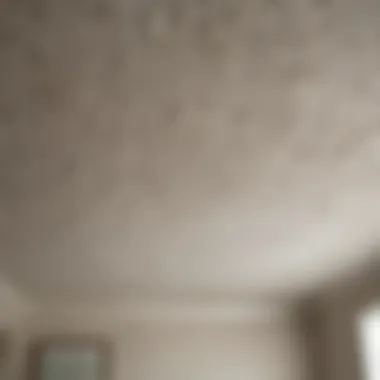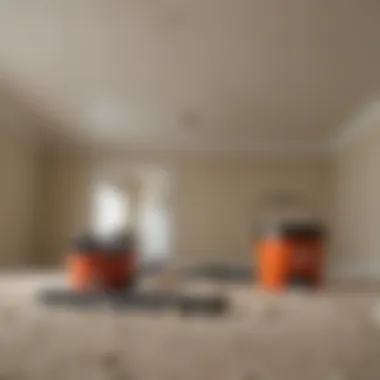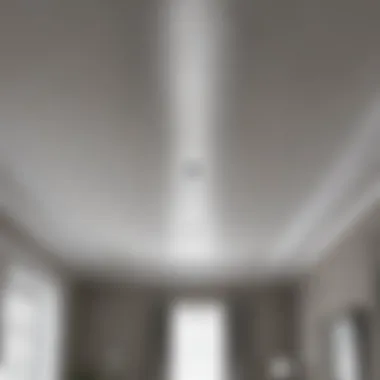Expert Guide to Removing Popcorn Ceilings


Intro
Popcorn ceilings, once a popular choice for homeowners, have become less favored in modern interior design. Their textured surface and dated appearance can detract from the overall aesthetic of a home. This article provides a detailed guide on removing popcorn ceilings, covering everything from historical context to practical tips and safety precautions. Understanding the relevance of this topic helps in making informed decisions about home renovations.
In recent years, many homeowners have sought to modernize their living spaces by eliminating popcorn ceilings. This transformation helps not only in improving visual appeal but also in enhancing property value. As styles evolve, the desire for smoother ceiling finishes has grown. The methods and tools available for removal have also advanced, making the process more accessible for those willing to take it on as a DIY project or those seeking professional assistance.
Key Insights and Trends
Current trends in interior design
Today, many interior designers and homeowners lean towards minimalist aesthetics. Smooth, flat ceilings are in demand due to their ability to reflect light and create a sense of spaciousness. The trend emphasizes simplicity, clean lines, and a cohesive look throughout living spaces. Removing popcorn ceilings aligns perfectly with this shift, allowing for greater customization during renovations.
Moreover, the focus on sustainability in interior design has highlighted the importance of using safer materials and effective techniques. For instance, finding eco-friendly paint and ceiling treatments becomes a priority when updating the ceiling after removal.
Practical Tips and How-To Guides
Step-by-step guides for home decoration projects
- Assess your ceiling: Before beginning, determine if the popcorn ceiling contains asbestos, a common material used in homes built before the 1980s. If it does, contact a professional for safe removal.
- Gather necessary tools: You will need a putty knife, scraper, spray bottle, ladder, protective goggles, and drop cloths.
- Prepare the room: Remove furniture and cover the floor with drop cloths to catch any debris.
- Make the popcorn wet: Fill a spray bottle with water, lightly spray the ceiling to moisten the texture, and allow it to sit for about 15 minutes. This will help loosen the texture.
- Scrape away the texture: Starting from the edges, use the putty knife to gently scrape off the popcorn material. Be careful not to damage the ceiling underneath.
- Smooth the ceiling: Once removed, fill any imperfections with joint compound, letting it dry completely before sanding to a smooth finish.
- Final touches: Paint the ceiling to achieve the desired modern finish.
By breaking down the popcorn ceiling removal process into manageable steps, homeowners can feel empowered to take on this task.
"Removing popcorn ceilings can dramatically change the look of your home, transforming a dated aesthetic into a sleek, modern space."
Entertaining tips for a smooth transition
When planning to host events in your newly renovated space, consider the following:
- Choose a versatile paint color for the ceiling that complements your overall decor.
- Select appropriate lighting that enhances the smooth surface, providing an inviting atmosphere.
- Decorate with statement pieces that draw attention away from the ceiling and add character to the room.
By incorporating these elements, homeowners can maximize the impact of their renovations during gatherings.
For further reading, you can check more about interior design trends on Wikipedia or explore discussions on Reddit about home renovations at Reddit.
Understanding Popcorn Ceilings
Understanding popcorn ceilings is essential for homeowners considering their removal. This type of ceiling texture, often characterized by its bumpy, irregular surface, has been a common feature in many residences. As interior designs evolve, tastes shift towards smoother, cleaner lines. Recognizing the historical context and reasons for the original popularity of popcorn ceilings adds depth to the decision-making process. Furthermore, knowing current trends allows one to make informed choices that enhance the overall aesthetic of a home.
Historical Relevance
Popcorn ceilings can be traced back to the 1950s when they gained prominence in post-war housing construction. Builders favored them for several reasons, including cost efficiency and time-saving properties. The texture was initially seen as a way to minimize imperfections, create acoustic control, and provide a modern look. However, this design choice, though practical in its time, is now often viewed as outdated. The historical relevance of popcorn ceilings serves as a reminder of how design trends evolve based on changing preferences and societal values.
Reasons for Popularity
The 1960s and 70s saw exponential growth in the popularity of popcorn ceilings. They were marketed as an innovative way to hide flaws in ceilings without extensive repairs. Additionally, the bumpy texture claimed to absorb sound, making homes feel quieter. For many homeowners, this was an attractive feature. However, these ceilings can accumulate dust and cobwebs easily, leading to maintenance challenges. The initial appeal of popcorn ceilings might have overshadowed the long-term implications, which are now more widely recognized.
Modern Trends and Preferences
In recent years, there has been a significant shift in interior design towards minimalism and sleek finishes. Smooth ceilings are now preferred for their clean lines and modern appeal. This change reflects broader trends that prioritize simplicity and elegance in design. The rise of open-concept floor plans also highlights the need for cohesive and uniform ceiling aesthetics. Consequently, many homeowners are reconsidering their popcorn ceilings in light of contemporary standards and values.
"Homeowners are increasingly aware of how aesthetics affect the overall feel of their living spaces. Removing popcorn ceilings can drastically elevate both style and value."
The move away from popcorn ceilings does not just involve personal style; it often connects to larger discussions around property value and maintenance. Knowing this context sets the stage for evaluating whether removal is the right choice in the homeowner's journey.
Evaluating the Need for Removal
Understanding the necessity for removing a popcorn ceiling is a crucial step before undertaking the task. Different factors can influence this decision, and recognizing them early helps homeowners achieve their desired outcome. The evaluation process revolves around aesthetic preferences, health risks, and property valuation. Each of these elements plays a significant role in determining whether removing a popcorn ceiling is essential or beneficial.
Assessing Aesthetic Preferences


Aesthetics directly impact the ambiance and style of a home. Popcorn ceilings were once popular for their textured look, but many homeowners now prefer smoother finishes. An assessment of your aesthetic preferences involves considering your personal style and the overall design of your space.
- Smooth ceilings can make a room feel larger and more modern.
- Contrasting personal taste with current trends may lead to dissatisfaction if a popcorn ceiling is left in place.
Homeowners should also evaluate the cohesion of their interior designs. Is the popcorn ceiling clashing with other modern elements in your home? If so, removal may enhance the visual appeal significantly.
Identifying Potential Health Risks
Health risks are another vital factor during this evaluation. It is essential to recognize that older popcorn ceilings may contain asbestos, a harmful material linked to serious respiratory issues. Identifying potential health risks means:
- Conducting a test for asbestos: This is the most proactive way to ensure safety in your living space. Hiring a professional for testing and potential removal is often advisable to manage these risks effectively.
- Considering dust and allergens: Even without asbestos, popcorn ceilings can trap dust, leading to poor indoor air quality. If allergies or respiratory conditions are a concern, removing the ceiling can lead to a cleaner environment.
Considering Property Value
Evaluation must also account for property value, particularly if the homeowner intends to sell or rent. Potential buyers often view popcorn ceilings as outdated and less desirable.
- Market perceptions: Homes with smoother ceilings generally attract buyers at higher prices due to the modern touch they exhibit.
- Investment vs. return: Weighing the costs of removal against the potential uplift in property value is a critical consideration. Homeowners should ask themselves:
- Will this renovation significantly enhance appeal?
- Will it contribute positively to my property’s market value?
Assessing these points illuminates the multifaceted considerations involved in deciding to remove popcorn ceilings. In making a decision, homeowners can align their choices with their preferences, safety, and overall property value.
Preparation Steps for Removal
The process of removing popcorn ceilings involves several crucial preparation steps. These initial actions are essential to ensure a safe and efficient removal process. Preparing properly can help prevent damage to your home, reduce the risk of hazards, and create a smoother workflow during the actual removal.
Gathering Necessary Tools
Having the right tools is fundamental when removing a popcorn ceiling. The primary tools you will need include:
- Spray bottle: Fill this with water to apply moisture to the popcorn texture, making it easier to scrape off.
- Scraper or putty knife: A wide blade will allow you to peel off the texture without damaging the underlying surface.
- Ladder: To reach high areas safely.
- Drop cloths: Protect the floor and furniture from debris and moisture.
- Masking tape: For securing the drop cloths in place.
- Protective goggles and face mask: Essential for keeping dust and particles away from your eyes and lungs.
When you have everything at hand, it saves time during the removal process and minimizes interruptions.
Protecting Surrounding Areas
Before any work begins, it is vital to protect surrounding areas. This protects your furniture and other belongings from dust and paint splatters.
- Remove or cover furniture: If possible, take furniture out of the room. If moving it is not an option, cover it with plastic sheeting to prevent damage.
- Seal vents and doors: Use plastic sheeting and masking tape to seal off doorways and vents. This step is crucial to prevent dust from spreading through your home.
- Cover floors: Lay down drop cloths or old blankets to catch debris and moisture. This makes cleanup more manageable.
Taking these precautions ensures that the aftermath of the removal does not lead to additional work later.
Testing for Asbestos
It is crucial to test for asbestos before beginning the removal of a popcorn ceiling, as this material presents a significant health risk when disturbed.
Understanding Asbestos Risks
Asbestos, once popular for its insulating properties, is now known for being hazardous. When fibers are inhaled, they can lead to serious health issues. Understanding the risks associated with asbestos is essential before starting the removal process. Key characteristics of asbestos include:
- Carcinogenic Properties: It can lead to lung cancer and mesothelioma.
- Latent Effects: Symptoms may not appear until years later, increasing potential health risk.
Recognizing these facts makes it imperative to handle popcorn ceilings with care. Ignoring the presence of asbestos can have severe consequences, and it is vital to approach the removal cautiously.
Methods for Testing
There are several methods for testing for asbestos in your popcorn ceiling. Home test kits are available and can provide initial insights. However, hiring a professional can yield more reliable results. Methods for testing include:
- DIY Test Kits: Available at hardware stores. These can be easy to use and affordable.
- Professional Inspection: Engaging a licensed asbestos inspector guarantees accurate assessment.


The advantage of home kits is speed and cost, but they do not always replace the expertise of a professional. Being thorough ensures that the environment remains safe throughout the removal process.
Removal Techniques
Removal techniques are a vital part of understanding how to effectively eliminate popcorn ceilings. These methods vary widely, catering to different skill levels, tools available, and financial considerations. Knowledge of these techniques helps homeowners make informed choices that suit their preferences and situations. Each removal method comes with particular advantages and disadvantages which must be carefully weighed.
DIY Methods
Removing a popcorn ceiling on your own can be a rewarding project. DIY approaches often save money and give you control over the process. Two prominent techniques stand out:
Water and Scraper Technique
The water and scraper technique involves moistening the ceiling with water and using a scraper to remove the popcorn texture. This method is popular due to its simplicity and effectiveness. The key characteristic of this method is its requirement for minimal specialized tools, allowing homeowners to use household items such as a spray bottle and a putty knife.
Considering the potential water damage, areas should be protected effectively before starting.
Using a Popcorn Ceiling Remover
Using a popcorn ceiling remover is another effective method for tackling this project. This tool is designed specifically for the removal of textured ceilings, making it quite efficient. The key characteristic of a popcorn ceiling remover is its ability to cut through the texture without excessive damage to the underlying drywall.
A major advantage of this method is time-saving. It often allows for a cleaner removal with less chance of spontaneous mess compared to traditional scraping methods. However, it does involve an upfront cost to purchase or rent the equipment.
Hiring Professional Services
Some homeowners may opt to hire professionals for popcorn ceiling removal. This choice can alleviate stress and ensure a clean finish. Professionals possess the skills and tools necessary to complete the job efficiently. When considering this option, it’s essential to research local contractors and read reviews. This ensures that the selected service meets specific quality expectations.
Cost Comparison
When evaluating removal techniques, cost plays a crucial role. DIY methods typically have lower out-of-pocket expenses, primarily covering materials such as water, scrapers, and protective gear. However, the labor and time investment should also be factored into calculating total costs.
On the other hand, professional services generally lead to a higher initial expense but may save money in the long run. Hiring experts can protect against potential damages or take longer if novices mishandle the removal, thus affecting value in the event of property resale.
Safety Considerations
Removing popcorn ceilings requires careful attention to safety considerations. This aspect is crucial, as it affects the well-being of individuals involved in the process, whether they opt for a DIY approach or hire professionals. Proper safety precautions mitigate risks associated with exposure to harmful materials, ensure a safer environment, and create efficient workflow during the removal process.
Personal Protective Equipment (PPE)
Utilizing appropriate Personal Protective Equipment is essential during the removal of popcorn ceilings. This equipment helps prevent injuries and exposure to hazardous materials. Key items include:
- Safety Goggles: Protects eyes from dust and debris.
- Respirators or Masks: Prevents inhalation of potentially harmful particles, especially if asbestos is present.
- Gloves: Shields hands from sharp objects and chemical irritants.
- Coveralls: Keeps skin protected and limits exposure to contaminants.
Wearing the right PPE is a non-negotiable step in ensuring health and safety during the task.
Ventilation Requirements
Ensuring proper ventilation in the workspace is another pivotal safety consideration. Inadequate ventilation can lead to the accumulation of dust and harmful particles, which may cause respiratory issues. Here are some recommended practices:
- Open Windows: Create airflow by allowing fresh air to enter the space.
- Use Fans: Direct fans to facilitate air circulation, helping to remove dust quickly.
- Seal Off Areas: Close doors to limit dust spread to other parts of the home.
A well-ventilated environment promotes a healthier workspace and reduces the chances of inhaling toxic substances.
Recognizing Potential Hazards
Awareness of potential hazards is vital. Identifying these risks ensures that adequate measures are in place. Some hazards to be mindful of include:
- Asbestos Exposure: If the ceiling was installed prior to the 1980s, asbestos may be present. This substance poses serious health risks, and proper testing should be conducted.
- Falling Debris: Removing popcorn ceilings can lead to loose materials falling. Be cautious and use protective equipment to guard against injuries.
- Electrical Hazards: Be aware of any electrical wiring that may exist within or near the ceiling. Turning off power can prevent accidental electrocution.
Recognizing these potential hazards empowers individuals to take the necessary precautions, ensuring a safer removal process.


"Safety is not just a policy; it’s a culture that starts before the work begins and continues until the last detail is completed."
Post-Removal Steps
After the removal of popcorn ceilings, a series of post-removal steps becomes critical in ensuring a successful transition to a more contemporary aesthetic. This stage is about preparing the ceiling surface, deciding on paint options, and performing final inspections. Proper execution of these steps not only enhances the visual appeal of the ceiling but also contributes to the overall value of the space.
Surface Preparation
Surface preparation is the first task after removing the popcorn texture. This process involves scraping off any remaining glue, dust, or debris that may have been left on the ceiling. It is essential to ensure the ceiling surface is smooth and free from imperfections before any painting occurs. An ideal method to achieve this is through sanding. Using a fine-grit sandpaper helps in creating a smooth texture, which is essential for an even paint application.
Key Steps for Surface Preparation:
- Inspect for any damages. Look for cracks or holes that need filling.
- Use a patching compound for any imperfections to create a flat surface.
- Sand down the entire area gently to avoid damaging the underlying drywall.
- Finally, wipe down the surface to remove any dust.
This attention to detail plays a significant role when considering the final aesthetics. A well-prepared surface can make all the difference in the appearance of the paint job.
Painting Options
Choosing the right paint is crucial. A good choice not only covers the ceiling well but also adds durability. Choosing the Right Paint can enhance the overall appearance of the room. Opt for a high-quality, low-VOC paint for better indoor air quality. This is especially relevant considering the historical presence of harmful materials in popcorn ceilings.
Choosing the Right Paint
In selecting paint, consider its composition and application properties. An important characteristic of quality paint is its ability to resist stains and mildew, which aids in long-term maintenance. Furthermore, lower VOC (volatile organic compounds) paints are less harmful to indoor air quality, making them a beneficial choice for health-conscious homeowners. A unique feature of these paints is that they often have better adherence properties, allowing for fewer coats needed during application.
Advantages of Choosing the Right Paint:
- Enhanced durability against wear and tear.
- Improved airflow quality within the home.
However, one disadvantage could be a higher initial cost; yet, most homeowners find this investment worthwhile due to the benefits.
Types of Finishes
The finish type will influence not only the look but also how well the surface holds up over time. The key characteristic of different finishes varies in terms of gloss and durability. Popular choices include matte, eggshell, satin, and semi-gloss. Each serves its own purpose and complements specific designs.
For instance, matte finishes can hide imperfections well, but they may not be as wash-friendly as glossier finishes. On the contrary, semi-gloss finishes are easier to clean and work well in high-moisture areas. Thus, knowing which type to choose plays a fundamental role in the longevity and practicality of painted ceilings.
Unique Features of Finish Types:
- Matte: Conceals imperfections but can absorb stains.
- Eggshell: A balance of durability and appearance, suitable for living areas.
- Satin: Excellent for high-traffic areas, has a soft sheen that’s also easy to clean.
- Semi-Gloss: Best for areas requiring extra durability and washability.
Each finish type can complement a room's design, but homeowners should select based on personal preferences and practical needs.
Final Inspection and Touch-ups
Once the painting is complete, the final inspection serves as a critical step to ensure all aspects are as planned. This includes checking for any missed spots, uneven areas, or errors that may have arisen during the painting process. Taking the time for touch-ups is important. Using the same paint used earlier can repair minor flaws and provide a cohesive look across the ceiling.
Long-Term Maintenance Tips
Maintaining a ceiling that has undergone removal of popcorn texture is crucial for preserving its new appearance and ensuring durability. After investing time and possibly money into the removal process, attention must shift to long-term care strategies. This will prevent future damage from moisture, pests, or daily wear and tear, allowing the freshly finished surface to retain its aesthetic appeal.
Preventing Future Damage
Preventing damage starts with an understanding of potential threats to the ceiling's integrity. Here are several important factors to consider:
- Moisture Control: High humidity can lead to water damage or mold growth. Ensure that rooms are properly ventilated to keep moisture levels in check. Use exhaust fans in kitchens and bathrooms to mitigate moisture accumulation.
- Regular Inspections: Check the ceiling periodically for signs of cracking or discoloration. Early detection of issues can save considerable repair costs.
- Pest Management: Keep an eye out for pests that may damage the ceiling structure. Regular pest control measures can prevent infestations that might compromise your ceiling’s integrity.
Ceiling Care and Cleaning
Cleaning protects your ceiling while also enhancing its overall appearance. Here are a few strategies to maintain a clean and appealing ceiling:
- Gentle Cleaning Solutions: Use mild detergent and warm water to clean minor stains. Avoid using harsh chemicals, as they can damage paint finishes.
- Dusting Techniques: Dust can accumulate on ceilings, no matter how careful you are. Use a microfiber cloth or a duster on a long handle to gently remove dust without scratching the surface.
- Avoid Abrasive Tools: When cleaning the ceiling, refrain from using steel wool or abrasive sponges. These can lead to scratches and permanent damage.
"A well-maintained ceiling not only enhances the interior look of your home but also contributes to the overall value of the property."
In summary, applying these long-term maintenance tips is essential to enjoy a clean and appealing ceiling. This diligence ultimately preserves the aesthetic value of your space and prevents costly future repairs.



